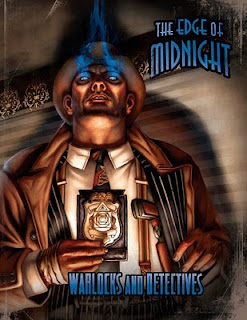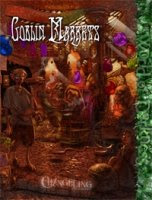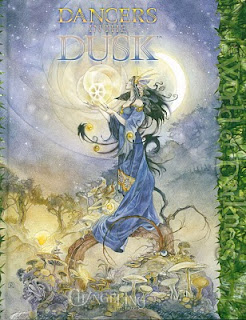Preliminary NoteWith this I hit my 20th review of the 30 I have planned for October. Today's review is a little longer as I cover several products rather than one. I'm only going to count it as two reviews, so I can take Saturday off from posting!IntroductionSince I reviewed
The Edge of Midnight rpg yesterday, I thought it might be worth doing a run-down set of mini-reviews for the three sourcebooks published for this setting. It strikes me as one of those criminally overlook game settings well deserving of a second look. So below you'll fin d a description of each of the books, their value to someone thinking about running EoM, and if the material here might be useful for GMs running other games.
 GAUNTS AND THE UNDERWORLDOverview
GAUNTS AND THE UNDERWORLDOverviewReaders might be forgiven for thinking this book only deals with the Gaunts, since underworld's a term thrown around in connection with them in the core book. However this volume (and
Warlocks and Detectives) splits its attention evenly between two groups. First, is surveys the Underworld of the
Edge of Midnight setting: con-men, thieves, gangsters, and felons. Second, it hits the Gaunts, humans who have been transformed by a supernatural virus. That change gifted them with abilities while simultaneously making them hideous and pushing them to the margins of society. Both sections provide GM information as well as suggestions for how players could build those characters. The book mentions early that players might want to check with their GM about what they should read or not read- an ultimately unsatisfying approach to dealing with the
player-information problem.
The UnderworldThe material on crime takes up the first two-thirds of this 176-page book. As with the main book, the text design is tight and dense. That makes just a casual perusal a more daunting task. On the other hand, the book focuses much more heavily on background information, setting details and ideas than it does on mechanics or system information. Each of the four chapters on criminals talks about how those groups appear in the world, detailed methods of operation, and how PCs might come across them. I expected that the sections might provide some new character options-- to make up for the relatively lack of "cool" offered to non-Warlock and non-Gaunt characters in the main book. But there's nothing like that here. Instead we get an incredibly thorough and detailed examination of how things like con games work, how robbery operations go down, and how a criminal syndicate functions. Everything works to support the noir setting and background. Most of it could be applied to any game in this genre.
GauntsThe Gaunt section of the book expands on the already pretty extensive coverage of this group from the main book. There's more focus here on Gaunt culture-- including religion within that group (something I hadn't considered in going through the core book). This section talks about a Gaunt campaign and the thematics of playing a shunned minority group. That's a classic theme in more modern approaches to noir (less so in earlier stories). I find that a little interesting given that we're echoing a period which already had a great deal of prejudice and ethnic tension regarding existing groups (Blacks, Asians, Hispanics). It does make me wonder if creating a fantasy analogue for those groups makes dealing with those questions easier and more palatable in a game.
The last part of the
Gaunts and the Underworld also spends some time considering Gaunts as criminals-- both their own networks and as members of existing criminal groups. I like that we get some specific integration between the two halves of the book. It also looks at how Gaunts function as player characters in a mixed group as well as how a purely Gaunt-based campaign might work. As with other sections, the book provides a number of interesting campaign frames for that. Most, if not all, of the material in this part of the book is narrative rather than mechanical. No new character creation options, backgrounds or skills only really show up in a 2+ page appendix at the back-- keeping it from getting in the way of the setting description.
For Edge of Midnight GMsI don't think
Gaunts and the Underworld is an essential book for running the setting, but it is incredibly useful. If you plan on having conventional crime and criminals be a central part of the campaign, then you'd want to pick this up. Given that we're talking about a noir setting that's pretty likely.
PortabilityThe first 120 pages of the book will be of great use to anyone running a 20th-century campaign. Ideas about crime and how that might intersect with the PCs' stories is well worth it. It is an excellent resource-- like a better and more focused version of some of those
Writers Digest books on crime writing. While the material comes from the particular
Edge of Midnight setting, it could be applied to most other games with little work. The appendix of slang terms at the back will be especially useful for noir GMs.
 WARLOCKS AND DETECTIVESOverview
WARLOCKS AND DETECTIVESOverviewLike
Gaunts and the Underworld, this volume deals with two separate aspects of the
Edge of Midnight setting. It also continues the tradition of naming the book one way and then having the order of materials be opposite. The first section of covers detectives of all kinds-- police, private investigators and vigilantes. The second section looks closer at Warlocks, the generic name for spell-casters in the setting. It provides a little more background, an actual tradition of magic and a number of Warlock organizations. Again this is a sourcebook intended for both players and GMs but there's not clear separation of that material. For NPCs, organizations and plots with secrets, GMs will have to consider what the players may have read.
DetectivesThe material on detectives takes up about 106 pages of the 176-page book. It opens with an extensive and freakishly detailed section on crime scenes, investigation, and mysteries. Over the course of 22 dense pages, the authors provide a primer on forensics in the broadest sense. We get diagrams of how teams arrange themselves when tailing a suspect; an illustration of the different types of fingerprints; on-scene processes; definitions of trace evidence; and so on. While the material is keyed to the time period of the game (late 40's, early 50's) it has general application. There's nothing here in a way of mechanics-- just notes for the GM and players on how to handle an investigation scenario. For gamemasters wanting to create a sense of verisimilitude, it would be a great resource. For
Gumshoe players it could be especially useful.
After discussing general investigations, the book covers three kinds of detectives and the particular situations they face. What's noticeable here- as in the Gaunts and Underworld book- is that the unique aspects of the setting: magic, Gaunts, memory problems do get mentioned but the greater focus remains on how these things function in the day-to-day. The Law Enforcement section provides a run down of typical crimes and how they get dealt with. It also considers difficult situations like Internal Affairs and corrupt cops. National Law Enforcement gets several pages of discussion as well. The Private Investigator chapter looks at the difficult lives they face and the questionable legality of some of their methods. Ideas for methods, kinds of cases and PI archetypes flesh out the text. The chapter on Vigilantes considers both the revenge seeking adventurer and also the more extreme costumed avenger. Again there's good solid material here for these kinds of characters as PCs or as someone crossing the group's path. Each chapter includes campaign frames for how a GM might set up a campaign revolving exclusively around that group.
WarlocksThe last 60+ pages of this volume considers Warlocks, those trained in the power to manipulate physical forces in the world. The first chapter of this section echoes and expands on material appearing in the core book. It provides more detail on police "Crystal Ball Squads" where Warlocks oversee other Warlocks- a nice connect to the first part of the book. There no new mechanics here- mostly NPCs, thoughts on what Warlocks face and their treatment. The last chapter presents a number of Warlock organizations and groups-- providing some rich for for GMs wanting to expand the occult underground in their game.
Sandwiched in between those two chapters is one which brings something new to
The Edge of Midnight. The eleven pages dealing with Voudoun throws a wrench into the magical cosmology established-- or so it would appear at first glance. In standard EoM, Warlocks practice a “magic” which is a kind of science, affecting basic natural forces. While there might be some superstitions and treatment of that magic as dark-- it doesn't seem to have any connections to 'classical' magic as presented in history. Here we have a tradition presented which has come through and its practitioners require the use of ritual to carry out their magics. Mind you, those magics remain the same set of powers available to conventional Warlocks but they require a different approach. In some ways that's a cop out, but in others it does open of the possibility of having Warlocks with a slightly different approach or ethos. My one big objection to this section is that it in a couple of places it references and spoils significant setting material from the GM's section of the core book. That's really sloppy.
The Warlock section as a whole is decent and interesting, providing some new ideas on how to use them in a campaign. Once again there's nearly no mechanical material in this sourcebook. Only at the end do we get two pages of new rules for additional backgrounds and professions.
For Edge of Midnight GMsNot to be too repetitive, but again this isn't an essential book for running the setting, but it is incredibly useful. If you plan on having crime and detection be a central part of the campaign, then you'd want to pick this up. The Warlock material is optional and interesting but not essential.
PortabilityThe first 100+ pages of
Warlocks and Detectives will be of great use to anyone running a 20th-century campaign. Ideas about law enforcement, detectives and how those could intersect with the PCs' stories make it worth it. As with the Gaunts and the Underworld this provides an excellent resource-- like a better and more focused version of some of those Writers Digest books on crime writing. While the material comes from the particular Edge of Midnight setting, it could be applied to most other games with little work. GMs of pulp adventurer games (ala
The Spider; Justice, Inc; or
The Shadow) ought to pick this up.
 THE NAKED CITYOverviewThe Naked City
THE NAKED CITYOverviewThe Naked City sourcebook covers the cities and locations of
The Edge of Midnight. The core book for the game covers the city of Gateway (the San Francisco analogue), while this book presents five others. It also provides a chapter on other locations, the borderlands (literal and figurative) of this magical noir universe. Once again this is a 176 page book with a dense text design. Little in the way of specific mechanics appear. Instead it provides background details and notes. Three pages at the end do present some new backgrounds and professions.
The player information problem rears its head again in this book. The introduction tries to split the difference by suggesting players should check in with GMs. Why not say this is a GM-only book? Or better yet, why not actually provide some split of material between player facing and GM facing ideas?
CitiesThe first five chapters each cover an individual city in the Edge of Midnight world. Those are:
* Central City: The Chicago analogue for the setting. Of course organized crime and the mob take center stage here in this crossroads of the United Commonwealth.
* New Eden: The New York of EoM: While organized crime appears here, the focus seems to be on wealth and power as a motivating factor in daily lives.
* Nova Roma: The capitol of the United Commonwealth: The beating heart of political corruption with an attitude of extreme prohibition towards magic.
* Paradiso: The Los Angeles analogue: It lies as the border of Belacatan, the clumsily named Mexico-esque neighboring country.
* Terminus: Standing in for New Orleans and all of the other southern metropoli: Closest to the Cuban analogue of Iberana there's a sense of the mythic pervading the atmosphere.
The book does a nice job of distinguishing each city. There's the lingering question in the setting of how much everyone remembers about the past. GMs can play that up more as an aspect of the noir genre or as a strange Dark City-like facet. Each city has a different way of dealing with its own history, though that's discussed more explicitly in some of the chapters than others. I like the strange open nature of the game and the map- suggesting but not confirming that these might actually be the only major cities in the country. That's kind of a creepy thought- with everything in the middle as flyover country or the backwoods. Don't think too hard about the actual logic of that.
Each chapter begins with a decent map-- more to show the general "shape" of the city. Some places are loosely numbered on the map, but the details pretty minimal and arbitrary. An Overview gives a general perspective on the history and tone of each city. This would probably be the best information to provide a PC. Pretty extensive discussions of both Crime and Law Enforcement in the city follow. The chunkiest section of each chapter covers the various neighborhoods of the city. That provides some named locales and features for the GM. Several pages of NPCs- usually tied to the earlier material- appear. Some of these provide more interesting hooks than others, but gamemasters can probably find something to use here. Lastly each chapter suggests a couple of campaign possibilities for the city. The book gives about 25 pages or so to each one.
BorderlandsThe last chapter of the book covers everything else. I was excited that we might get some more general discussion, but we only get five pages covering rural areas and small towns bordering the major six cities. That could have easily been developed further. After that the book deals with the Borderlands of neighboring states. On the one hand I was a little worried since the nebulousness of the world outside the United Commonwealth seemed to be part of the setting. However the book doesn't range too far.
Instead it sticks pretty close to the expected stereotypes-- for better or worse. The noir genre often plays off of and reinforces those stereotypes so it is to be expected. And what would be a Los Angeles-type story without a run to the Mexican border.
A Touch of Evil remains one of the most important noir touchstones. We get a version of Mexico (Belacatan), Cuba (Iberana), a revolutionary control country (Nuevo Dia) and a Banana Republic (Santo Baltasar). One has to give the authors crdit for covering all of the basics. Each has some background, a few locations and some NPCs provided. The chapter ends with some suggestions about how to use these places in a campaign.
ExpectationsI'll confess I was a little disappointed with
The Naked City as a sourcebook. Keep in mind that I love city books generally- they're my favorite kind of rpg book. Urban games are my favorite, where you have a static setting which can develop as a character for the campaign. I expected that
The Naked City would provide some generic tools, ideas and resources for cities in the
Edge of Midnight setting. Describing each city, while useful, isn't as useful as some general material (ala the
Citybooks series or something like that). I expect the designers have a pretty clear sense of the world they've built and want ot get that across. However I'd be willing to bet that most campaigns actually stick to one city, with a trip to another one being a rarity. While that doesn't make the material in each chapter useless, it does mean that GMs will have to lift and modify from one chapter to the next.
For Edge of Midnight GMsThis is probably the least essential of the three
Edge of Midnight sourcebooks. If you plan to move things outside of the Gateway campaign city then you might want to pick it up. As well if you want some general location and plot suggestions to pick up and replant in the campaign city, this could be a good source.
PortabilityThere's some good stuff here-- but mostly as a mine for ideas and details. I can imagine using some of this in a Pulp game, for example. I hit a few "wow-- great idea" moments in reading through, so if you're someone who does pick up sourcebooks for ideas, and you have an interest in noir, then its worth buying.











